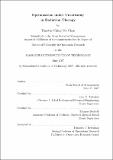| dc.contributor.advisor | John N. Tsitsiklis. | en_US |
| dc.contributor.author | Chan, Timothy Ching-Yee | en_US |
| dc.contributor.other | Massachusetts Institute of Technology. Operations Research Center. | en_US |
| dc.date.accessioned | 2008-02-27T20:36:33Z | |
| dc.date.available | 2008-02-27T20:36:33Z | |
| dc.date.copyright | 2007 | en_US |
| dc.date.issued | 2007 | en_US |
| dc.identifier.uri | http://hdl.handle.net/1721.1/40302 | |
| dc.description | Thesis (Ph. D.)--Massachusetts Institute of Technology, Sloan School of Management, Operations Research Center, 2007. | en_US |
| dc.description | This electronic version was submitted by the student author. The certified thesis is available in the Institute Archives and Special Collections. | en_US |
| dc.description | Includes bibliographical references (p. 175-182). | en_US |
| dc.description.abstract | In the context of patient care for life-threatening illnesses, the presence of uncertainty may compromise the quality of a treatment. In this thesis, we investigate robust approaches to managing uncertainty in radiation therapy treatments for cancer. In the first part of the thesis, we study the effect of breathing motion uncertainty on intensity-modulated radiation therapy treatments of a lung tumor. We construct a robust framework that generalizes current mathematical programming formulations that account for motion. This framework gives insight into the trade-off between sparing the healthy tissues and ensuring that the tumor receives sufficient dose. With this trade-off in mind, we show that our robust solution outperforms a nominal (no uncertainty) solution and a margin (worst-case) solution on a clinical case. Next, we perform an in-depth study into the structure of different intensity maps that were witnessed in the first part of the thesis. We consider parameterized intensity maps and investigate their ability to deliver a sufficient dose to the tumor in the presence of motion that follows a Gaussian distribution. We characterize the structure of optimal intensity maps in terms of certain conditions on the problem parameters. | en_US |
| dc.description.abstract | (cont.) Finally, in the last part of the thesis, we study intensity-modulated proton therapy under uncertainty in the location of maximum dose deposited by the beamlets of radiation. We provide a robust formulation for the optimization of proton-based treatments and show that it outperforms traditional formulations in the face of uncertainty. In our computational experiments, we see evidence that optimal robust solutions use the physical characteristics of the proton beam to create dose distributions that are far less sensitive to the underlying uncertainty. | en_US |
| dc.description.statementofresponsibility | by Timothy Ching-Yee Chan. | en_US |
| dc.format.extent | 182 p. | en_US |
| dc.language.iso | eng | en_US |
| dc.publisher | Massachusetts Institute of Technology | en_US |
| dc.rights | M.I.T. theses are protected by copyright. They may be viewed from this source for any purpose, but reproduction or distribution in any format is prohibited without written permission. See provided URL for inquiries about permission. | en_US |
| dc.rights.uri | http://dspace.mit.edu/handle/1721.1/7582 | |
| dc.subject | Operations Research Center. | en_US |
| dc.title | Optimization under uncertainty in radiation therapy | en_US |
| dc.type | Thesis | en_US |
| dc.description.degree | Ph.D. | en_US |
| dc.contributor.department | Massachusetts Institute of Technology. Operations Research Center | |
| dc.contributor.department | Sloan School of Management | |
| dc.identifier.oclc | 191106158 | en_US |
